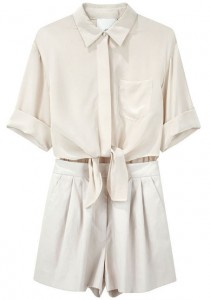 Someone please figure out my size and get me this. (Philip Lim romper via lagarconne.com)
Someone please figure out my size and get me this. (Philip Lim romper via lagarconne.com)
It is about time.
In one store, you’re a Size 4, in another a Size 8, and in another a Size 10 — all without gaining an ounce.
It’s a familiar problem for many women, as standard sizing has never been very standard, ever since custom clothing gave way to ready-to-wear.
So, baffled women carry armfuls of the same garment in different sizes into the dressing room. They order several sizes of the same shirt online, just to get the right fit.
Now, a handful of companies are tackling the problem of sizes that are unreliable. Some are pushing more informative labels. Some are designing multiple versions of a garment to fit different body shapes. And one is offering full-body scans at shopping malls, telling a shopper what sizes she should try among the various brands.
This is such a frustrating problem for women of all sizes. I understand the purpose of vanity sizing — if someone who is usually a size 6 fits into a size 2, she’s perhaps more likely to purchase that garment. And I’ve certainly hesitated to size up because the number seemed too high. But vanity sizing makes size tags virtually meaningless, and makes shopping much more challenging (especially if you don’t want to spend an hour trying on clothes at the store, or if you prefer to shop online):
Take a woman with a 27-inch waist. In Marc Jacobs’s high-end line, she is between an 8 and a 10. At Chico’s, she is a triple 0. And that does not consider whether the garment fits in the hips and bust. (Let’s not get into length; there is a reason most neighborhood dry cleaners also offer tailoring.)
There’s a class aspect to this as well. Higher-end brands, I’ve noticed, are sized much smaller than middle-market and mall-store clothes. The cuts, too, are different — mall-store brands like Ann Taylor, Banana Republic and J Crew are not only wildly over-sized as a general rule (especially Ann Taylor, sweet Jesus), but also cut wider in the waist. I am by no means a tiny person, but I don’t even attempt to go shopping at the Gap (or a lot of similar national stores) anymore, unless it’s for an over-sized sweater, because I’m going to waste my time trying on a million different ill-fitting items. Talking about this stuff can feel a little bit whine-braggy (“Ugh don’t you hate it when you don’t even fit into a size zero?”), but really, tiny sizes should fit tiny people (and I am not in their ranks). At the same time, a lot of these stores don’t advertise or adequately stock plus-sized clothes, so larger women aren’t going to walk in, either. And as the Times article details, pants that fit my short legs and big butt and thick thighs and smaller waist are not going to fit my friend’s long skinny legs and straight waist; so why are we both trying on the same size and the same cut?
Stores should be able to cater to larger people by adding additional sizes, not just by cutting garments larger and calling them size 10. It goes back, in part, to how size is tied not only to perceptions of attractiveness but also to social class. Carrying sizes in the 16+ range can add to the perception that a store is down-market; if the store is Chico’s then it’s no biggie, but if it’s J. Crew, that’s going to be a marketing problem. Instead of offering sizes for a wide range of bodies, stores will cut a size 14 to fit a size 20 so they don’t lose the larger customer (and in turn, the size 8 customer fits into a size 2 and feels great and buys more clothes). But stores also can’t afford to lose their smaller customers, so Size 2 items in a particular store have wildly different measurements. The small (but not too small) woman can usually find something and the large (but not too large) woman can usually find something too, but neither of them can walk in to any given store and grab their size and be reasonably confident it will fit.
And despite vanity-sizing and cutting clothes larger and larger, women who are size 20 plus (and there are a lot of women who are size 20 plus) are generally out of luck when it comes to shopping at stores that don’t advertise themselves as “plus-sized.” And since there are so few plus-sized stores, there are not only fewer options generally, but far fewer choices when it comes to cut — and a pear-shaped size 24 is going to fit clothes very differently than a size 24 who carries her weight at her waist. At least if you’re a size 6 (even if that means your clothing tags list sizes that range from 2 to 10) you can try on 15 different pairs of pants at 6 different stores; if you’re a size 20-something, you’ve got Lane Bryant and maybe one or two others.
It would be nice if women’s clothes, like men’s, were sized in inches and were fairly standard; it would also be nice if so much value weren’t assigned to the size on your pants tag.